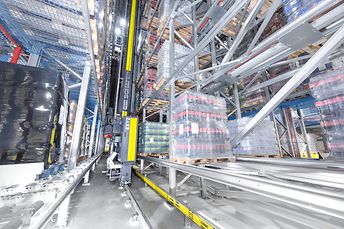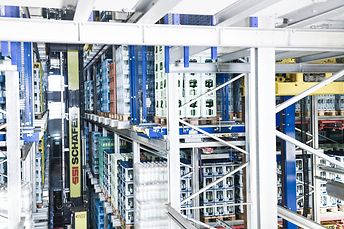Harnessing the Transformative Power of Cold Chain Logistics with SSI Schaefer
As average global temperatures rise and the demand for cold-chain storage grows worldwide, SSI Schaefer, a global leader in intralogistics and automated warehouses, is sharing best practices and key considerations on how logistics and operations managers can optimize efficiency and cost-effectiveness of cold storage warehouses.
Cold storage warehouse managers — particularly in the food and beverage industries, but also pharmaceutical distribution — are facing the need to efficiently and effectively store, pick, retrieve, pack, and ship perishable and sensitive goods, which require special handling, monitoring, and carefully tuned environmental conditions. Yet they face additional challenges — the cold-chain storage market is expanding, with some reports projecting a CAGR of 9% from 2023 to 2028, meaning that warehouse managers must balance surging demand for cold-stored goods with the increasing need to reduce energy costs and carbon emissions.
“What we are seeing for refrigerated supply chains is this pinch — a need to do ever more with ever less,” notes Carsten Spiegelberg, Managing Director - Middle East & Africa, SSI Schaefer. “To meet the growing complexities of the industry, it’s not enough to find a quick fix. Companies need material flow experts with industry know-how to consider all angles of a facility and seamlessly blend cold-chain logistics solutions with individual processes.”
Cold chain storage solutions
Careful planning is always the first step in optimizing temperature-controlled infrastructure. To increase efficiency and cost-effectiveness of cold storage warehouses, there are several factors to consider from the beginning.
Optimizing air circulation and product storage density
Since different products and comestibles require different storage temperatures, cold storage warehouse temperatures can range from -34°C to 0°C, with some even reaching 21°C. However, there is often a trade-off between storage density and air flow. Selecting the right storage system that enhances the cooled air circulation while increasing the storage density in the given facility footprint is critical in the planning phase.
Semi-automated solutions for cold storage space optimization
Ideal for deep-freeze facilities for bulk storage in the manufacturing sector and delivering maximum space utilization, channel storage setups with semi-automated drive-in racking systems are an accessible step towards automation, offering high throughput, enhanced safety, and reduced time for workers in refrigerated facilities. Capable of following either the Last in-First Out (LIFO) or the First in-Last Out (FIFO) principle, these systems use channel vehicles like SSI Orbiter® and a corresponding docking station to store and retrieve pallets.
Compared to a static, manual pallet rack system, a mobile racking storage system is an effective way to boost storage capacity in a given space — by up to 85%, while maintaining full selectivity typically required in distribution centers. This system involves racks that move along floor rails via electric motors to create an aisle only where needed, and it offers smart lighting that only activates in occupied aisles for reducing energy consumption, as well as a night parking option that optimizes rack spacing for maximal cold air circulation.
Future-ready automation systems for a seamless, cost-optimized cold chain
Due to the need for cold goods to maintain strict timetables and a closed cold chain, storage systems must handle incoming goods efficiently and cope with expected and unexpected upticks in demand. The best way to systematically manage the complexities of cold-chain material flows is with a fully automated storage system that seamlessly interconnects components, such as:

Pallets:
Automated storage & retrieval systems (ASRSs): The SSI Exyz is an automated high-density storage system with extremely high space utilization, particularly in high-bay warehouses, and it saves 25% of energy compared to conventional machines while functioning across different temperatures.

Shuttle solutions: As a future-proof, fully automated channel storage option, the SSI Lift & Run Shuttle System (SLR) provides simultaneous access to multiple racks for top-tier performance and high storage density.
Other storage types:
Shuttle solutions for layer trays: For high-volume picking of goods such as comestibles for shop deliveries, tray shuttles and conveying systems enable fully automated robotic picking or support efficient semi-automatic goods-to-person picking.
Storage solutions for container, bin and carton loads: For loads of varying dimensions, scalable solutions using SSI Miniload, Flexi Shuttle or Cuby maximize storage density while accommodating specific load and performance requirements to support automatic or semi-automatic case and piece picking.
Platforms for central control of refrigerated facilities
Although there are various warehouse automation technologies that track material flows, issues such as coordinating multiple systems often arise and there is a clear need for centralized monitoring and control—particularly with the complexities of refrigerated facilities. To tie all aspects of a cold storage warehouse together, end-to-end software such as WAMAS® or SAP EWM (Extended Warehouse Management) offer clear visualizations and comprehensive tools to manage processes, resources, and stock levels.